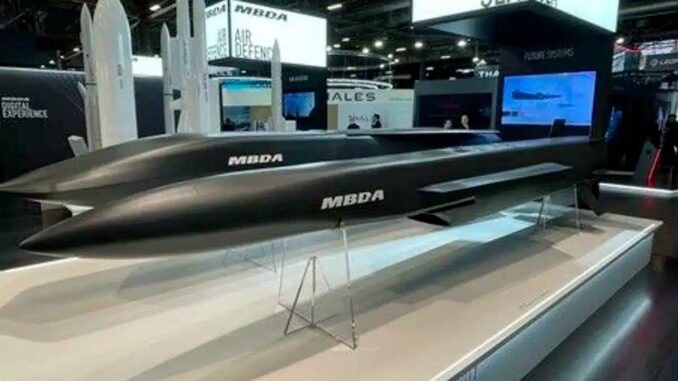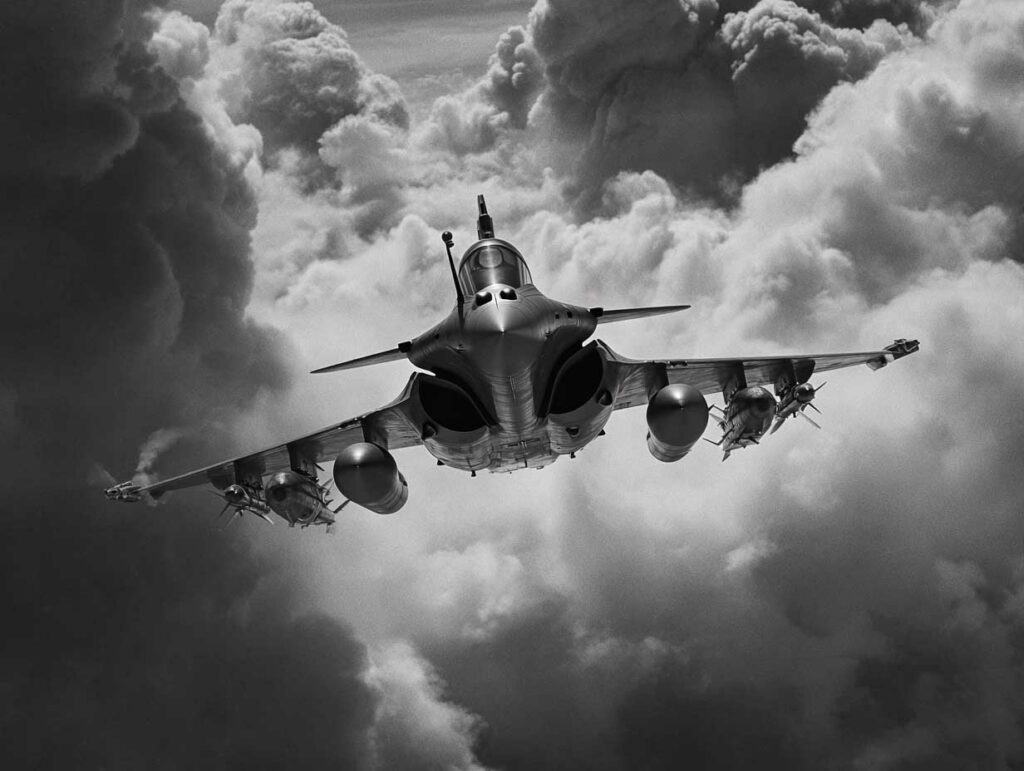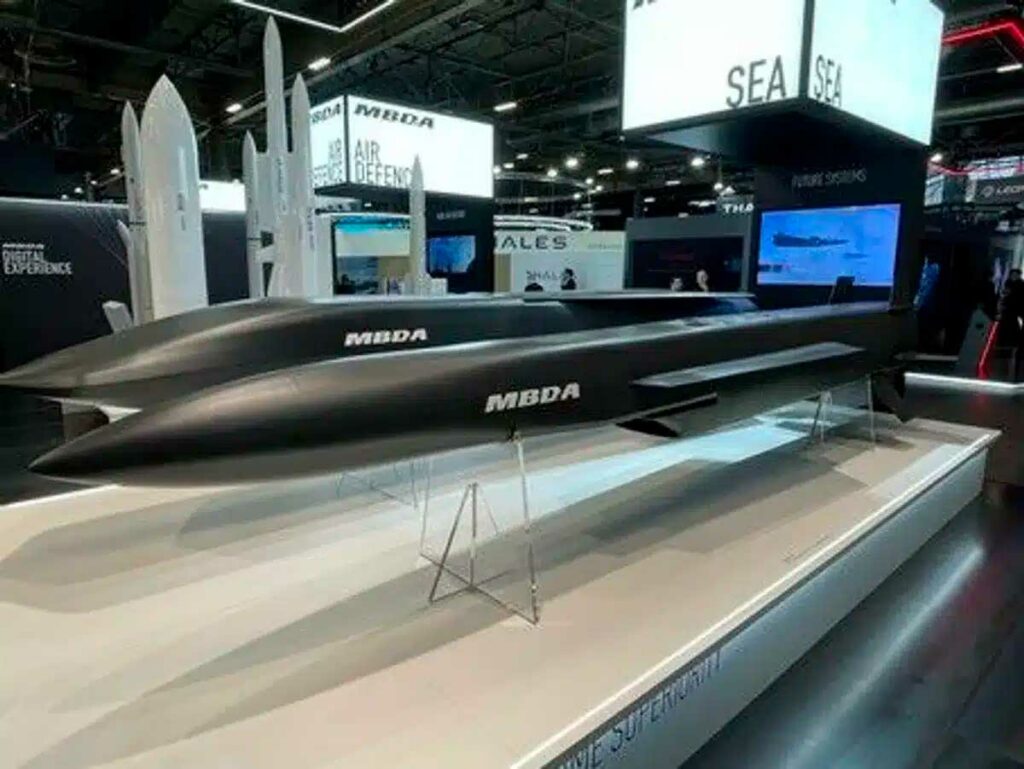
The future RJ10 missile will propel the Rafale F5 into a new strategic role, based on long-range engagement and coordination with drones.
The Rafale F5, the future standard French fighter, will be equipped with a long-range supersonic anti-radar missile derived from MBDA’s RJ10 to compensate for its lack of passive stealth. This weapon will enable neutralization of enemy radar systems at ranges of over 500 kilometers, at speeds exceeding Mach 3.5. Developed as part of the 2024-2030 Military Programming Law, this missile fills a SEAD (Suppression of Enemy Air Defense) capability gap that has existed since the late 1990s. Coupled with combat drones derived from the Neuron, Remote Carrier vectors and MALE drones, the Rafale F5 will now operate under a distributed engagement doctrine, favoring coordinated strikes, collaborative warfare and survival in heavily defended environments.

The strategic return of SEAD capability for French forces
Since the withdrawal of the AS-37 Martel missile, the French armed forces have had no electronic suppression of air defenses capabilities. Unlike several NATO partners, France has never equipped the Rafale with anti-radar missiles such as the AGM-88 HARM.
Recent conflicts, particularly the war in Ukraine, have highlighted the tactical importance of multi-layered ground-to-air systems capable of deterring or blocking the action of fighter fleets. Although the Rafale performs well in contested environments thanks to its SPECTRA system, it remains vulnerable to modern radar defenses, particularly those of Russia and China.
The 2024-2030 Military Planning Law has therefore included a priority capability requirement: to design a national anti-radar missile compatible with the future Rafale F5 standard. This requirement is based on several observations:
- Current munitions (AASM, SCALP-ER) are not designed for the specific neutralization of radars.
- Passive countermeasures are reaching their limits against modern AESA radars.
- Long-range engagement limits human and material risks while maintaining the desired strategic effect.
The RJ10 anti-radar missile, scheduled to enter service in 2035, is part of a strategy of enhanced conventional deterrence and protection of major vectors (aircraft, drones, satellites). It will complement the future ASN4G missile, successor to the ASMPA-R nuclear missile, underscoring strategic consistency in the upgrading of French air assets.
A long-range missile derived from the RJ10: characteristics and performance
The announced missile will be an anti-radar variant of the RJ10, a supersonic cruise missile developed as part of the Franco-British FMAN/FMC program.
The RJ10 anti-radar will have a range of over 500 kilometers and a sustained supersonic speed of over Mach 3.5. This profile will enable it to:
- Reduce its exposure time to defenses,
- Cross radar layers in low-altitude flight or on a ballistic trajectory,
- Surprise enemy systems with its approach speed.
In comparison:
- The American AGM-88G HARM reaches Mach 4, with a range of approximately 350 kilometers.
- The British SPEAR EW does not exceed 150 kilometers at subsonic speed.
The RJ10 is likely powered by a compact ramjet or turbojet engine, combined with optimized flight inertia. Its payload will be dedicated to neutralizing radar emitters through kinetic strikes or directed detonation, with guidance based on:
- Electromagnetic emission detection (ESM),
- Inertial navigation coupled with latest-generation sensors,
- Mission interruption options if the emitter stops transmitting.
The missile could also be equipped with a secondary passive reconnaissance capability, or serve as an advanced jamming platform.
Its integration into the Rafale F5 involves upgrades to the wiring, computers, data fusion, and onboard electrical power, provided by an improved version of the M88 engine, called T-REX.
A distributed engagement architecture centered on the Rafale F5
The Rafale F5, expected in 2030, will not be stealthy. It will simply be discreet thanks to optimized radar and thermal signature management. Faced with high-intensity threats, this requires a remote engagement doctrine: engage without being engaged.
The RJ10 anti-radar missile then becomes a tactical key. By striking surveillance or fire control radars several hundred kilometers away, the Rafale can remain in the background while clearing the way for other effectors.
This strategy is accompanied by a new kill chain logic, where the Rafale no longer plays alone. It acts as a conductor, receiving, processing and redistributing data from:
- Heavy combat drones, derived from the Neuron (18 tons in combat weight),
- Expendable remote carrier drones, designed to identify and designate targets,
- MALE drones (Eurodrone, Aarok type), acting as communication relays or extended ISR stations.
This networked architecture makes it possible to process mobile or stealth targets, adjust strikes in real time, and protect manned platforms from immediate threats.
Thus, even without intrinsic stealth, the Rafale F5 becomes the central node of a system of systems, where each vector has a specific and coordinated function. This makes it possible to adapt to modern air defenses without resorting to a monolithic solution.

A strategic alternative to the “Super-Rafale” concept?
With the emergence of the Rafale F5, equipped with the RJ10 anti-radar missile and integrated into a constellation of drones, the relevance of a stealth Super-Rafale is increasingly being debated.
Initially envisaged as an industrial response to the absence of SCAF before 2040 and as a commercial counterpart to the F-35, the Super-Rafale, redesigned to incorporate advanced passive stealth, would be costly, time-consuming to certify, and difficult to make profitable.
Conversely, the Rafale F5 + drones solution offers several advantages:
- Industrial responsiveness: the technological building blocks are already in development,
- Tactical flexibility: remote engagement can be adapted to different theaters,
- Economy of means: the Rafale does not need to enter the enemy’s defensive bubble.
However, this approach is based on one key condition: that the Rafale F5 and its heavy drone are produced in sufficient numbers and at a controlled cost.
If each Rafale + drone pair costs close to the price of a single stealth fighter, the model remains viable. But if the cumulative cost exceeds that of a single F-35A or NGF, then the question of the Super Rafale could resurface, particularly in order to maintain a consistent fleet size.
The debate therefore remains open. The choice will depend on budgets, exports, industrial maturity and, above all, the reliability of the operational performance expected from this new tactical ecosystem.
War Wings Daily is an independant magazine.